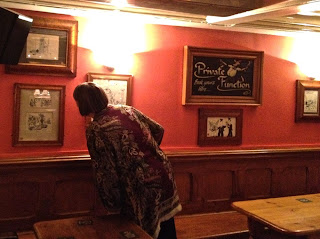Fleet Street, former center of the universe for journalists and printers. Nice mosaic advertising on the left-side building.
Somerset House. I'd heard it announced on Tube trains as a place to exit, but didn't know what it was. As we walked along the Strand we saw an entrance to a courtyard and went in to find this exhibit of 10,000 ceramic blooms placed in the grass courtyard. Somerset Place, as it used to be called, was originally built by the Duke of Somerset. After he was executed at Tower Hill it was used by Princess Elizabeth before she became Queen Elizabeth (mid-1500s). The east wing now forms part of King's College London.
Never know what you'll run across as you walk around London.
For instance, this is another courtyard that caught our eye as we walked along the Strand. No idea what this is about, but it's impressive.
Just another ordinary building on the Strand.
Lots of pubs in the Strand and Fleet Street area. The George has been here since 1723. Samuel Johnson, author of A Dictionary of the English Language (1755), used The George as his postal address for a while.
The hand-carved exterior decorations of The George are beautiful, if not puzzling. They depict naked men chasing geese, pigs, and roosters. Makes perfect sense to me.
We find ourselves at the Inner Temple again. The Inner Temple and this entire area is one of four Inns of Court in London, professional associations for judges and lawyers. Dating back to the 1300s.
Inner Temple window.
Inner Temple entrance.
A tour guide tells her group about the Inner Temple.
Robin reads a plaque about the history of the Inner Temple.
One of the courtyards in the Temple area.
The Middle Temple, in an adjoining courtyard.
Detail of the Middle Temple entrance.
One of the entrances to the Temple courtyards. Just assume everyone you see in this area is a lawyer or a judge.
It could be my imagination, but the number of pubs seems to increase with the number of lawyers and judges in the area.
It's 5 p.m. Do you know where your lawyer is? Standing outside the nearest pub, I'll bet.
I'm sure someone is getting billed by the hour for this.


















































